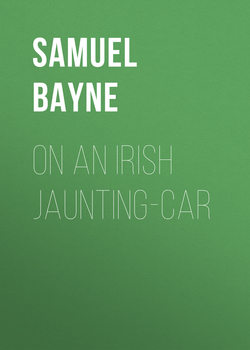Читать книгу On an Irish Jaunting-car - Bayne Samuel Gamble - Страница 3
LONDONDERRY TO PORT SALON
ОглавлениеWe leave Derry with regret, and take the train for Fahan. This brings us to the shore of Lough Swilly, where we embark on a ferry-boat and cross the lough to Rathmullen. While crossing I saw Buncrana, a short distance down the lough. This is a pretty village containing the castle of the O'Dochertys, now in ruins, and near it the castle erected by Sir John Vaughan at a later period. Half a century ago the latter became dilapidated, but it was restored and has ever since been rented "for the season," as an investment by the owner. One of my pleasantest recollections is the week's-end visit I made many years ago to its then tenant. It had fine, terraced gardens, its outer walls were skirted by a trout and salmon river, and there was a vast court-yard behind it with cell-stalls for the cavalry horses, and even a gallows on which to hang captured invaders – and many of them were hanged on this same gallows. It was not a pleasant outlook from one's bedchamber window, but then the victims had been a long time dead, and no trouble came from their ghosts.
We soon arrived at Rathmullen, a historic spot where many things happened in the days of yore. It occupies a sheltered position at the foot of a range of hills that intervene between Lough Swilly and Mulroy Bay, of which the highest point is Crochanaffrin, one thousand one hundred and thirty-seven feet. It is worth while to make an excursion either up this hill or Croaghan, one thousand and ten feet, which is nearer; for the extraordinary view over the inlets and indentations of this singular coast will put the traveller more in mind of Norwegian fiords than British scenery. Close to it are the ivy-clad ruins of a priory of Carmelite friars, consisting of two distinct buildings erected at an interval of nearly two centuries. The eastern portion, of which the tower and chancel remain, was constructed by the McSweenys in the fifteenth century. It exhibits considerable traces of pointed Gothic architecture. Over the eastern window there still remains a figure of St. Patrick. The architecture of the remainder of the building is of the Elizabethan age, a great part of it having been rebuilt by Bishop Knox, of the diocese of Raphoe, in 1618, on obtaining possession of the manor of Rathmullen from Turlogh Oge McSweeny. The Annals of the Four Masters (to which we will refer later), states that in 1595 it was plundered by George Bingham, son of the Governor of Connaught. McSweeny's castle is supposed to have stood west of the priory, but it was destroyed in 1516. It was from here that the young Hugh O'Donnell was carried off in 1587, and kept a prisoner in Dublin until he made his romantic escape in 1591. In 1607, the Earls of Tyrone and Tyrconnell took their "flight" from Rathmullen in a small vessel. "The entire number on board was ninety-nine, having little sea-store, and being otherwise miserably accommodated." After a hazardous voyage of three weeks, they landed at the mouth of the Seine.
There is a monument in the churchyard to the memory of the Hon. William H. Packenham, captain of the British man-of-war Saldanha, wrecked on Swilly Rock in 1811. Every soul on board was lost; the only living thing that reached the land was the captain's gray parrot, which the wind carried in safety to the rocky shore.
Here, too, Wolfe Tone was taken prisoner on board the French frigate Hoche, in 1798. Tone was a talented young Irishman, and pleaded the Irish cause so eloquently in Paris that a fleet of forty-three ships, with fifteen thousand men, was sent to Ireland in 1796, Hoche commanding. A tremendous storm scattered the fleet on the Irish coast, and the ships returned to France in broken order. Nothing daunted, Tone again persuaded the French to give him a trial with a new fleet. They gave it, but this expedition was even more unfortunate than the first one, and the end of Tone's tragic career dated from his arrest on the shores of Lough Swilly.
A few miles above, Lough Swilly divides into two forks, one running up to Letterkenny and the other to Ramelton, a little town located at the point where the river Lennon meets the tidal salt water. This interesting place is celebrated for the fine views it affords and for its salmon and trout fishing. I was exceedingly anxious to visit it, but time would not permit the shortest deviation from our rigid itinerary, as we had purchased a state-room on the Etruria, sailing from Queenstown on July 28th.
It was at Rathmullen that we hired our first jaunting-car; and it might here be said that of all the vehicles ever invented the modern Irish jaunting-car holds first place for the use of the traveller; it is unique and there is nothing that can take its place for an easy and comfortable lounging ride, when balanced by two passengers and a driver. It is now improved with a circular back and rubber tires, while the very latest has a driver's seat behind, like a hansom cab. We can speak truthfully of the jaunting-car, after having tested its qualities for three hundred and fifty miles on this trip; but would add that care is requisite in arranging for and selecting a car, as many of them are old and worn out.
